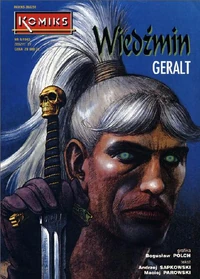"The Witcher" (Polish: Wiedźmin) is a short story written by Andrzej Sapkowski, having first been published in the Fantastyka magazine and later in the now obsolete book, Wiedźmin before being re-published in The Last Wish. It introduces the witcher Geralt and his famous fight with a striga.
Summary[]
The story begins with Geralt entering Vizima. Shortly afterwards, he kills three racist men in a bar fight, and is arrested by the City Guard and escorted to Velerad, the elderly castellan of Vizima. When asked to explain himself, Geralt refers to the bounty notices posted at the crossroads near Vizima, asking for an experienced monster hunter. At this point, Velerad tells Geralt of the striga and her origin. Near the beginning of King Foltest's reign, he got his sister, Adda, pregnant. She and the baby died giving birth, both being buried in a double coffin. Seven years later, the daughter awoke and slaughtered the inhabitants of the palace. She had become a striga.
Geralt meets with Foltest, who warns him not to harm the striga, for a wizard had told him that if someone prevented the striga from returning to her coffin by the third crowing of the rooster, then she would be cured, turning into an ordinary little girl. Geralt asks to see a miller (a survivor of one of the striga's earlier attacks). The soldier that brings him to Geralt is Foltest, disguised. He gives Geralt leave to kill his daughter if he found that she was an incurable case.
Geralt spends the night at the old palace (Foltest having moved to a new palace, unplagued by the striga's attacks). During the early night, Lord Ostrit, a magnate, tries to bribe Geralt into running away, as he wishes the striga to survive. This would eventually horrify the inhabitants of Vizima, who would more easily support Vizimir of Novigrad's rule. Geralt refuses, knocks Lord Ostrit out and ties him up. At midnight, he cuts Ostrit loose, using him as bait. He is soon found and killed by the striga.
Geralt fights with the striga, reluctant to use his silver sword. He ties the striga with a silver chain, which she breaks free of, despite silver being an antithesis to monsters of magic. She is eventually scared off when Geralt uses his sorcery to project the hate and malice in her own mind back at her. Geralt settles in for the night in the double coffin to wait for morning (not allowing the striga to sleep in her original coffin until the third crow of the rooster which would break the curse). In the morning, he sees an ordinary little girl who is lying on the floor. Leaning over her, he sees too late that her eyes are open. Using the last remnants of her talons, the striga slashes Geralt's throat. As he subdues the girl/striga, Geralt hears the third crowing of the rooster. Finally, he binds his neck, knowing he will faint.
The witcher wakes up, his neck bandaged, with Velerad (who was part of the group that had planned to just have the striga killed) admitting he was in the wrong. He assures Geralt that his silver sword, his three thousand oren reward and his possessions are safe. Geralt, soothed, falls asleep.
Characters[]
- Adda of Temeria (mentioned)
- Adda the White (daughter / striga)
- Dalka (mentioned)
- Foltest
- Geralt of Rivia
- Medell (mentioned)
- Ostrit
- Sancia of Sodden (mentioned)
- Lord Segelin
- Treska
- Velerad
- King Vizimir (mentioned)
Adaptations[]
Graphic novel[]

The Geralt graphic novel
The short story has been adapted as a graphic novel entitled "Geralt comic", written by Andrzej Sapkowski and Maciej Parowski, with art by Bogusław Polch.
The Hexer[]
The short story has been adapted as part of episode 8 of The Hexer TV series, titled "Rozdroże" ("Crossroads").
The Witcher[]
The intro sequence in The Witcher game is based on Geralt's fight with the striga in Vizima. The game also hints that although cured, there are rumours of Foltest's daughter Adda still having a striga's bloodthirsty heart. Other characters introduced in this story, such as King Foltest and Velerad, also appear in the game.
Netflix's The Witcher[]
The short story has been adapted in the Netflix TV series in its third episode titled "Betrayer Moon".
Translations[]
"The Witcher", being the first, is the most translated of Sapkowski's stories. There have been three translations of the story into English - by Agnieszka Fulińska, Michael Kandel and Danusia Stok.
Agnieszka Fulińska[]
Agnieszka Fulińska's translation was published as "Hexer" in the 2000 anthology Chosen by Fate.
Michael Kandel[]
Michael Kandel translated the story as "Spellmaker" for the A Polish Book of Monsters anthology. He took much liberty with the proper names, changing:
- Foltest to Hrobost
- Vizima to Klosthur
- Temeria to Kra
- Velerad to Ethmond
- Medell to Demell
- Striga to Gomb
- Mahakam to Apiph
- Ostrit to Osrugh
- Pontar to Fonzor
- Vizimir to Cuthbond (in one case) and Glothur (in another)
- Novigrad to Kloffok (in one case) and Globbur (in another)
Kandel's translation of the story was used by CD PROJEKT RED in promotional materials of their The Witcher, even though Kandel's versions of proper names were drastically different from the ones used in the game (which was generally more faithful to the Polish original).
Danusia Stok[]
Danusia Stok's translation in The Last Wish is generally faithful to the original when it comes to proper names, with only slight changes to help English readers with pronunciation of some of them.
Notes[]
- The story was strongly inspired by the Slavic folk tale Strzyga by Polish romantic writer Roman Zmorski.

